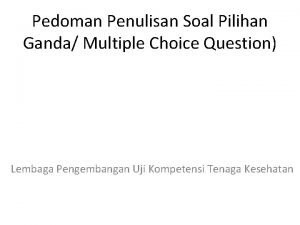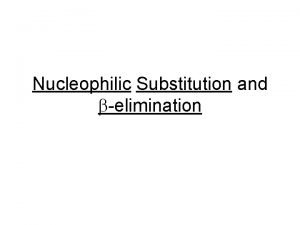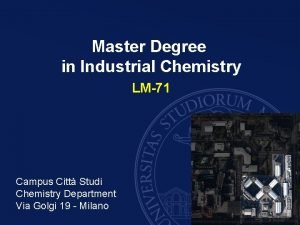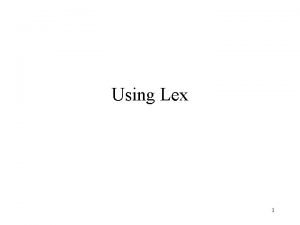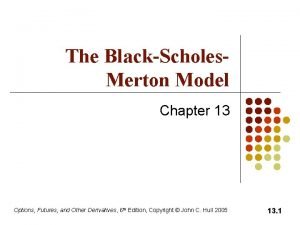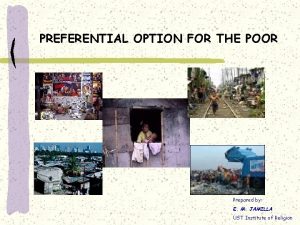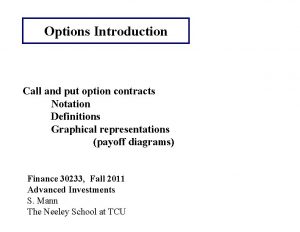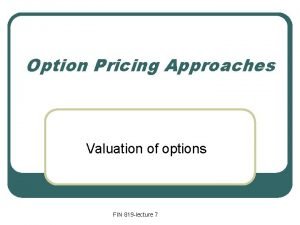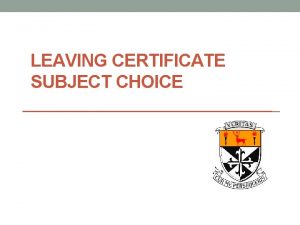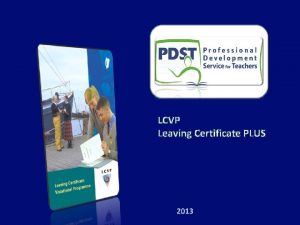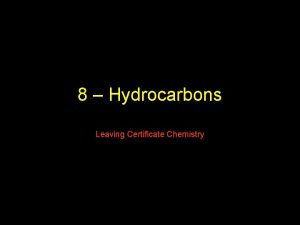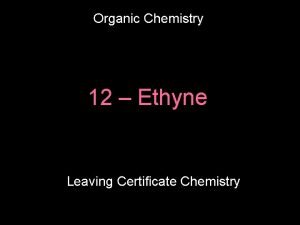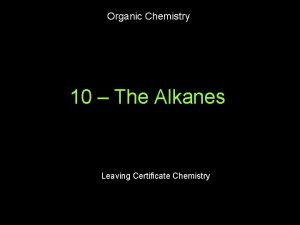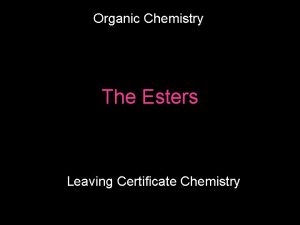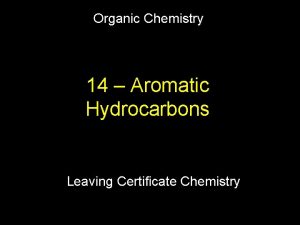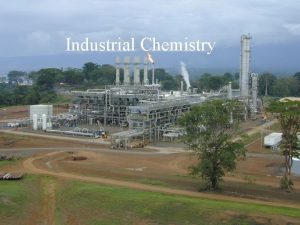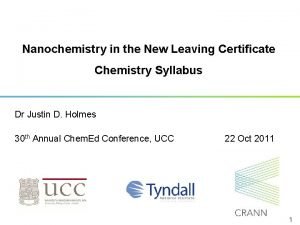Option Part 1 Industrial Chemistry Leaving Certificate Chemistry

























- Slides: 25

Option – Part 1 Industrial Chemistry Leaving Certificate Chemistry

Benefits of of Chemical Industries • Produces 1. necessary medicines 2. Chemicals for food industry - increases food output 3. health and hygiene products

Chemical Industry in Ireland Muspratt is credited with the beginning of the Irish Chemical Industry with the setting up of a plant in 1818 to manufacture chemical products such as hydrochloric and acetic acids and turpentine James Muspratt 1793 – 1886

Modern Industry in Ireland Pfizer Pharmaceuticals Co. Cork

Industrial Manufacturing Processes Batch Industrial Chemical Reactions take place in Disadvantage Advantage reactors a setto period Contamination of the of overallfor costs the timereactor to make product. batch – must be pharmaceutical plant Process repeated for a cleaned after each batch kept to a minimum. new batch. Continuous Industrial Chemical Reactions continuously Disadvantage Advantage take withfor the raw Veryplace high costs tolarge build suitable materials in at one end plants. scale fed production. and the product coming out at the other

Semi-Continuous Process • A combination of batch and continuous processes. Part of the operation is a batch process, usually the reaction step, and the separation stage might be run continuously using materials from several batch reactors.

Learning check. . . • What does batch processing mean? • Give one advantage and one disadvantage of batch processing. • What is an advantage of continuous processing? • Name a difference between batch and continuous processing?

The Manufacture of Ammonia and urea Nitrogen (N 2) + Hydrogen (3 H 2) High Pressure: 200 atm Ammonia (2 NH 3) Iron Catalyst 400 o. C Haber-Bosch Process

Haber process – continuous flow

Why manufacture Ammonia?

The Manufacture of Ammonia and urea

The Manufacture of Ammonia and urea Raw Materials Methane (CH 4) Air

The Manufacture of Ammonia and urea Raw Materials give us our feedstock Steam Reforming Methane (CH 4) CH 4 + H 2 O Methane (CH 4) is reacted with steam to give hydrogen 3 H 2 + CO

The Manufacture of Ammonia and urea Raw Materials give us our feedstock(reactants) Secondary steam reforming Air CH 4 + 2 O 2 Methane (CH 4) is reacted with oxygen to remove it from the air leaving mostly nitrogen 2 H 2 O + CO 2

The Manufacture of Ammonia and urea Rate (Speed) of Reaction A finely divided iron catalyst increases the rate of reaction

The Manufacture of Ammonia and urea Product yield Nitrogen (N 2) + Hydrogen (3 H 2) Ammonia (2 NH 3) 17 % Some of the ammonia is used to form urea – an excellent fertiliser

The Manufacture of Ammonia and urea What is a co- product? • A co- product is a product that is made alongside the principal product during the process.

The Manufacture of Ammonia and urea Co-products The carbon dioxide produced could be sold to the beverages industry to put the “fizz” into drinks Air CH 4 + 2 O 2 2 H 2 O + CO 2 Secondary steam reforming

The Manufacture of Ammonia and urea Co-products The carbon dioxide is removed on reaction with potassium carbonate solution CO 2 + H 2 O + K 2 CO 3 Air CH 4 + 2 O 2 2 KHCO 3 2 H 2 O + CO 2 Secondary steam reforming

The Manufacture of Ammonia and urea Co-products Urea is formed when ammonia reacts with carbon dioxide CO 2 + 2 NH 3 Ammonium Carbonate Dehydration gives urea Air CH 4 + 2 O 2 NH 2 COONH 4 + 2 H 2 O + CO 2 Secondary steam reforming

The Manufacture of Ammonia and urea Waste disposal & effluent control The discharge of ammonia or carbon dioxide could lead to pollution

The Manufacture of Ammonia and urea Quality control A QC control room sensors are available to monitor variables like temperature, pressure, p. H, flow rates of gases

The Manufacture of Ammonia and urea Fixed costs vs Variable costs Costs • Fixed cost – doesn’t depend on amount of product made • Variable cost –depends on how much product is made

The Manufacture of Ammonia and urea Costs Wages for employees Purchase of methane for process Electricity costs

The Manufacture of Ammonia and urea Site location – Cobh Cork Natural gas produced nearby Port nearby to transport products elsewhere Railway line nearby to transport products elsewhere
 Konvergensi option adalah
Konvergensi option adalah Stock options terminology
Stock options terminology Leaving cert history syllabus
Leaving cert history syllabus Primary leaving certificate
Primary leaving certificate Clonakiltycc vsware
Clonakiltycc vsware Leaving group
Leaving group Master’s degree in industrial chemistry
Master’s degree in industrial chemistry Addition symbol
Addition symbol Unit ratio definition
Unit ratio definition Part part whole
Part part whole What is a technical description
What is a technical description Under bar function
Under bar function The part of a shadow surrounding the darkest part
The part of a shadow surrounding the darkest part 미니탭 gage r&r 해석
미니탭 gage r&r 해석 Ib organic chemistry
Ib organic chemistry Organic vs inorganic chemistry
Organic vs inorganic chemistry Option adjusted spread
Option adjusted spread Option explicit vbscript
Option explicit vbscript Flex (lexical analyser generator)
Flex (lexical analyser generator) Black scholes call option formula
Black scholes call option formula Preferential option for the poor poster
Preferential option for the poor poster Option investing strategies
Option investing strategies Options notation
Options notation Options appraisals
Options appraisals Put price formula
Put price formula Option hacker
Option hacker
